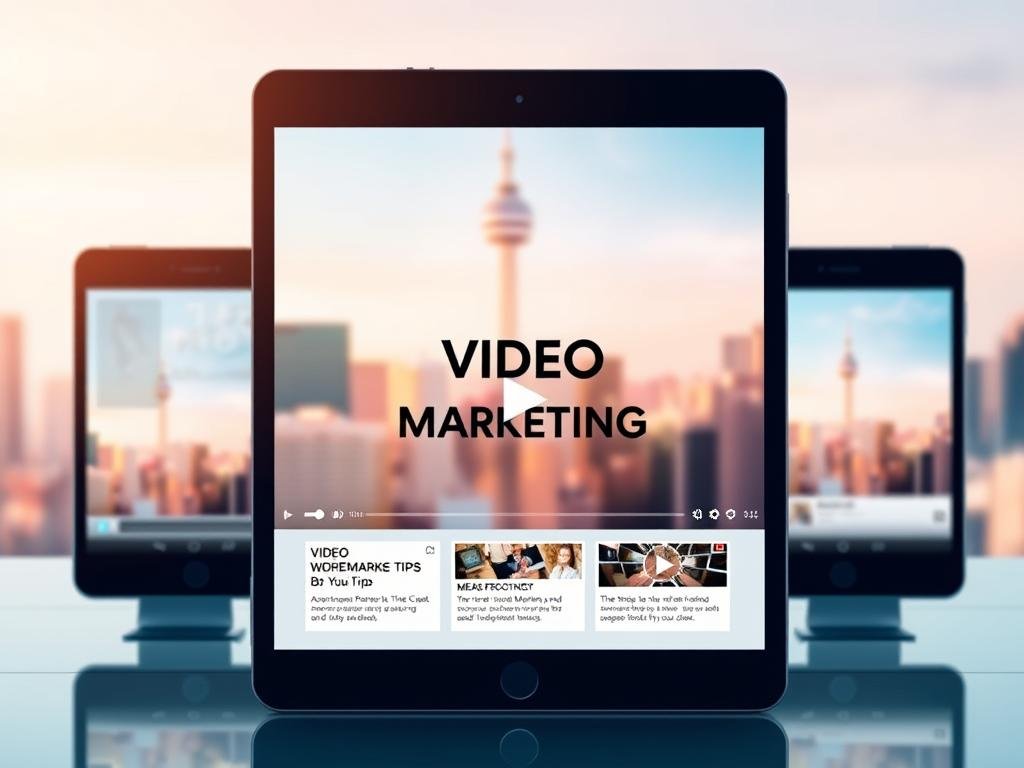Video Marketing 101. Did you know that 85% of businesses now use video as a marketing tool? This shows how big video marketing has become. As we move into 2025, using video content is essential for businesses to keep up.
To thrive, you need a solid video marketing strategy that speaks to your audience. This article will cover the basics of a winning strategy. You’ll get tips and examples to kickstart your journey.
Key Takeaways
- Understand the importance of video marketing in 2025
- Learn how to develop a complete video marketing strategy
- Discover key elements of a successful video marketing plan
- Get actionable tips and real-world examples to implement
- Stay ahead of the competition with the latest video marketing trends
Understanding the Importance of Video Marketing
Video content is now a key part of digital marketing. More people are looking for info and fun online, making video marketing very important. It helps grab and keep people’s attention better than ever before.
The Rise of Video Content in Digital Marketing
The world of digital marketing has changed a lot, thanks to new tech and how people act. Now, people like watching videos more than reading text because it’s more fun and real. This change means businesses are spending more on making videos for marketing.
Key Statistics You Should Know
Here are some important facts about video marketing:
- On average, people watch online videos for about two and a half hours each day.
- Nine out of ten people say videos help them make buying decisions.
- Video content is more likely to be shared on social media, increasing its reach and engagement.
These facts show how video marketing can grab attention and help sell things. By using video in your marketing, you can reach more people and make your brand stronger online.
Defining Your Video Marketing Goals
Setting your video marketing goals is key to success. You must match your video goals with your business aims. This ensures your video marketing helps your business grow.
Aligning Video Goals with Business Objectives
To make your video marketing work for your business, align your goals with your business aims. Know your company’s mission and what you want to achieve. Then, figure out how video marketing can help you get there.
For example, if you want more people to know about your brand, aim to make a certain number of videos. Make sure these videos speak to your audience to boost your brand’s visibility.
Examples of Measurable Video Goals
It’s important to set goals you can measure. This lets you see if your video marketing is working. Here are some examples:
- Increase video views by 20% in the next quarter.
- Get 30% more engagement (likes, comments, shares) in six months.
- Get 500 leads from video marketing in a year.
To track these goals, use analytics tools. Here’s how you might organize your video marketing metrics:
| Goal | Metric | Target | Timeline |
|---|---|---|---|
| Increase Video Views | View Count | 20% increase | Next Quarter |
| Boost Engagement | Likes, Comments, Shares | 30% increase | Six Months |
| Generate Leads | Lead Count | 500 leads | One Year |
By setting clear, measurable goals, you can create a focused video marketing strategy. This strategy will drive real results. Remember, success in video marketing comes from strategic efforts that align with your business goals.
Identifying Your Target Audience
To make great video content, you must know your audience well. Understanding your audience is key to a video marketing strategy that hits the mark. It’s not just about who they are; it’s about what they need, want, and do.

Tools for Audience Research
There are many tools to help you learn about your audience. These include:
- Social media analytics tools to understand audience engagement and demographics.
- Customer surveys and feedback forms to gather direct insights from your audience.
- Market research reports to stay updated on industry trends and audience preferences.
For a more detailed guide on finding your target audience, you can visit this resource. It offers deep insights into audience research for video marketing.
Creating Buyer Personas for Video Marketing
After gathering data, the next step is to create buyer personas. These are detailed profiles of your ideal customers. A well-made buyer persona helps you tailor your video content to meet your audience’s specific needs. This boosts the effectiveness of your video advertising techniques.
To make a buyer persona, think about age, gender, occupation, interests, and pain points. This info lets you create video content that speaks directly to your audience. It increases engagement and conversion rates.
Choosing the Right Video Types for Your Brand
Choosing the right video type is key to grabbing your audience’s attention. Different videos have different uses. Knowing these differences helps you make a strong video marketing plan.
Explainer Videos vs. How-To Videos
Explainer and how-to videos are common in marketing. Explainer videos introduce your brand, explaining how it works and its benefits. How-to videos show step-by-step how to use a product, making your brand a leader.
Think about your goals to choose between them. Explainer videos are great for new products. How-to videos are better for teaching customers how to use your product.
Live Streaming and Its Benefits
Live streaming is popular for real-time connection. It lets viewers ask questions and get answers right away. Use it for product launches, behind-the-scenes, webinars, and more.
Live streaming creates urgency and feels exclusive. It gets viewers engaged who might not watch pre-recorded videos.
User-Generated Content: A Powerful Tool
User-generated content (UGC) is when customers make videos about your brand. It’s a strong way to build trust and credibility. It shows real customers using and liking your product.
To get UGC, start a social media contest or campaign. Ask customers to share their experiences with your brand. For more on video types, check out Vidyard’s blog.
| Video Type | Purpose | Benefits |
|---|---|---|
| Explainer Videos | Introduce brand/product/service | Simplifies complex information, engaging introduction |
| How-To Videos | Educate on product/service usage | Establishes thought leadership, customer support |
| Live Streaming | Real-time engagement | Immediate interaction, creates urgency |
| User-Generated Content | Showcase customer experiences | Builds trust, credibility, and social proof |
Crafting Your Video Content Strategy
Creating a strong video content strategy is key to engaging your audience and meeting your marketing goals. A well-planned strategy helps you make content that speaks to your viewers. It drives engagement and turns viewers into customers.
The Role of Storytelling in Video
Storytelling is a powerful tool in video marketing. It helps you connect with your audience on an emotional level. By using video storytelling methods, your content becomes more relatable and memorable. Good storytelling has a clear start, middle, and end.
“Storytelling is the most powerful way to put ideas into the world today.”
To use storytelling in your videos, try these techniques:
- Use relatable characters or personas.
- Create an emotional connection with your audience.
- Use vivid imagery and descriptive language.
Scripting and Planning Your Videos
Scripting and planning are key steps in making effective video content. A well-written script clearly conveys your message. Start by defining your goals and understanding your audience’s needs.
For more detailed guidance on building a winning video marketing strategy, check out Lemonlight’s guide.
| Planning Step | Description |
|---|---|
| Define Objectives | Clearly outline what you want to achieve with your video. |
| Understand Your Audience | Research your target audience’s preferences and needs. |
| Script Your Video | Write a concise and engaging script that aligns with your objectives. |
Tips for Engaging Video Lengths
The length of your video matters a lot. Here are some general guidelines:
- For explainer videos, aim for 60-90 seconds.
- For how-to videos, consider lengths between 2-5 minutes.
- For live streaming, the ideal length can vary, but 30-60 minutes is a good starting point.

By using these strategies, you can make videos that engage, remember, and work well for your audience.
Optimizing Videos for SEO
To make your video more visible online, SEO optimization is key. Learning how to optimize your videos for search engines boosts their reach and visibility.

Best Practices for Video Titles and Descriptions
Your video title grabs viewers’ attention first. Make it descriptive and include your target keywords. For example, “How to Optimize Your Video for SEO: A Step-by-Step Guide” is better than “Video Tutorial.”
Descriptions add context for both viewers and search engines. Summarize your video and use relevant keywords naturally. You can also compare smartphone cameras to see how they impact video quality.
Key elements for effective titles and descriptions include:
- Relevant keywords
- Accurate descriptions
- Compelling language to boost engagement
The Importance of Thumbnails and Tags
Thumbnails grab viewers’ attention. Make them visually appealing and relevant. A good thumbnail can boost your video’s SEO.
Tags help search engines understand your video. Use specific and relevant tags. Avoid over-tagging to avoid being seen as spammy.
“The right thumbnail can increase your video’s click-through rate by up to 200%.”
Utilizing Transcripts and Captions
Transcripts make your video’s content easier for search engines to index. This improves your video’s visibility in search results.
Captions make your content more accessible and help with SEO. They give search engines more text to index, which can improve your video’s ranking.
Benefits of transcripts and captions include:
- Improved accessibility
- Enhanced SEO through additional indexable text
- Better viewer engagement due to increased accessibility
By using these strategies, you can boost your video’s SEO. This leads to more visibility and engagement. Remember, optimizing your videos is an ongoing process that needs constant monitoring and adjustment.
Leveraging Social Media for Video Marketing
In 2025, social media is key for video marketing success. YouTube, TikTok, and Instagram offer great chances for businesses. A good social media plan is vital to connect with your audience.
Top Platforms for Video Marketing in 2025
The social media world keeps changing, but some platforms are best for videos. YouTube is great for longer videos and SEO. TikTok is perfect for short, fun videos. Instagram is versatile with Reels, Stories, and IGTV.
- YouTube: Ideal for long-form content and SEO benefits
- TikTok: Perfect for short-form, engaging videos that can go viral
- Instagram: Offers versatility with Reels, Stories, and IGTV

Strategies for Organic Reach on Social Media
To boost organic reach, make high-quality, engaging videos that your audience loves. Use hashtags wisely and talk back to your viewers. This builds a community around your brand.
- Develop a content calendar to ensure consistency
- Use analytics to understand what works and adjust your strategy
- Encourage engagement by asking questions or prompting viewers to share their experiences
Paid Advertising Options for Videos
Paid ads on social media can help a lot. You can choose from many ad types, like sponsored content and video ads. This lets you target specific groups and interests.
When thinking about paid ads, remember:
- Targeting options to reach your desired audience
- Budget allocation to maximize ROI
- Ad creative that aligns with your brand and resonates with viewers
Using both organic and paid strategies on social media can boost your video marketing. This way, you can meet your business goals in 2025.
Analyzing Performance and Metrics
To make your video content more effective, it’s key to understand how to analyze performance and metrics. You need to track various data points. This helps refine your video production strategies and aligns them with your marketing goals.
Key Metrics to Track in Video Marketing
Several key metrics are important when analyzing video performance. These include:
- View count: The number of times your video has been viewed.
- Engagement rate: Likes, comments, shares, and other interactions with your video.
- Watch time: The total amount of time viewers have spent watching your video.
- Conversion rate: The percentage of viewers who completed a desired action after watching your video.
- Drop-off points: Areas in your video where viewers tend to stop watching.
By monitoring these metrics, you can understand how your audience interacts with your videos. You can also find areas for improvement.

Tools for Analyzing Video Performance
To analyze your video performance effectively, you need the right tools. Some popular options include:
- YouTube Analytics: Provides detailed insights into video performance on YouTube.
- Google Analytics: Offers a broader view of how your video content impacts your website traffic and conversions.
- Social media analytics tools: Most social platforms provide built-in analytics to help you track video performance.
- Third-party video analytics tools: Specialized tools that offer advanced features for video performance analysis.
These tools help you gather the data needed to make informed decisions about your video marketing best practices.
How to Adjust Your Strategy Based on Data
After gathering data on your video performance, it’s time to act on it. Start by looking for patterns and trends in your data. Are there certain types of videos that perform better? Are there specific times when engagement is higher?
Use these insights to adjust your video marketing strategy. This might involve:
- Refining your content to better match what resonates with your audience.
- Experimenting with different video formats or distribution channels.
- Optimizing your video titles, descriptions, and tags for better search visibility.
By continuously analyzing your performance and making data-driven adjustments, you can optimize your video marketing efforts for maximum impact.
Future Trends in Video Marketing
The world of video marketing is always changing. New technologies and how people act are driving these changes. It’s key to keep up and adjust your plans to stay ahead.
Impact of Emerging Technologies
Artificial intelligence (AI) and automation are changing video ads. They make ads more personal and work better. Using AI tools can make your videos perform better and save you money.
Preparing for the Next Generation
To stay on top, know the newest video SEO tricks. Use them in your plans. This means making your video titles, descriptions, and tags better. Also, use transcripts and captions. This way, you’ll be ready for new trends and tech.
Video marketing keeps getting more complex. It’s important to be quick to adapt to new ways people act and new tech. By using the latest video ad and SEO methods, your brand will stay seen and strong in a fast-changing world.
FAQ
What is the importance of video marketing in 2025?
Video marketing is key in 2025. It helps businesses grow online and connect with more people. It’s a powerful tool for reaching goals and boosting presence.
How do I define my video marketing goals?
First, link your video goals to your business aims. Make sure they are clear, reachable, and timely. Goals might include boosting brand awareness or driving sales.
What are the best types of videos for my brand?
The right videos for your brand depend on your goals and audience. Options like explainer, how-to, live streaming, and user-generated content are popular. They can educate, entertain, or engage your viewers.
How do I optimize my videos for SEO?
Improve your videos for SEO by focusing on titles, descriptions, thumbnails, and tags. Use transcripts and captions for better accessibility and search rankings. This boosts your video’s visibility.
What are the top platforms for video marketing in 2025?
Top platforms for 2025 include YouTube, Facebook, Instagram, and LinkedIn. They offer various ways to advertise and reach your audience.
How do I analyze the performance of my video marketing strategy?
Track views, engagement, and conversions to gauge your strategy’s success. Use tools like Google Analytics and social media insights to refine your approach based on data.
What are the future trends in video marketing?
Future trends include AI, automation, AR, VR, and personalized content. These will shape the future of video marketing, making it more interactive and engaging.
How can I leverage social media for video marketing?
Use social media for organic reach by creating engaging content and using hashtags. Consider paid ads on platforms like Facebook and LinkedIn to expand your audience.
What is the role of storytelling in video marketing?
Storytelling is vital in video marketing. It builds an emotional connection, shares your brand’s message, and makes content memorable and engaging.
How can I create engaging video content?
To engage your audience, script and plan well. Use storytelling and consider video length, format, and style. This will keep your viewers interested and attentive.
